Native Son – November, 2010
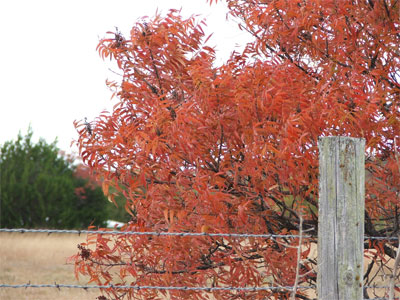
Smooth sumac (Rhus glabra) flaunts its brilliance along the roadside. All photos by Steven Chamblee.
Let’s Go For a Ride
Today I find myself perched atop a beautiful morning: the sun is shining, the air is chilling, the pups are snoozing (finally!), the Mexican coffee is steaming … and I’m off work!! Woo-hoo! R-r-r-road trip! Wanna come along? Hop in … wait, not yet! Come over here and check out this dragonfly on the ground … he’s too cold to fly yet today. I wonder if my hand will warm him up. Hmmm … maybe if I put him on my shirt and hold my coffee mug below him. He’s buzzing his wings now. There he goes! Cool beans … hop in!
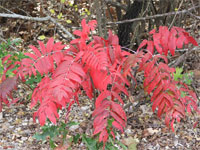
Smooth sumac (Rhus glabra) in full shade
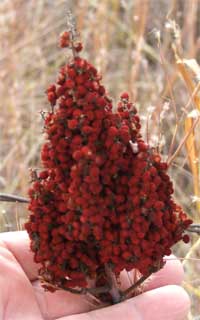
Smooth sumac (Rhus glabra) fruit
Giddy as two schoolgirls, you and I are gliding down good ol’ Garner Road, headed west and soaking in the colors of the season. Sumacs shine brightly from the roadsides, so we pull over to check them out. I assume from the “flaming” colors that these are flame-leaf sumac (Rhus lanceolata), but a quick inspection of the rachis (that central, stem-like part of the leaf) proves it to be smooth, so they’re not flame-leaf. How do I know? Since you are riding shotgun with me on this trip, let me tell you. Basically, there are seven species of sumacs native out here, and three of those have tiny leaves, so they’re out. Evergreen sumac has wider leaves, so that’s out. Of the three left, two have thin, leafy “wings” on the rachis, so they’re out. That leaves only one: smooth sumac (Rhus glabra).
While all of that may sound complicated, it really isn’t any different than quickly discerning a 1957 Bel Air coupe from the 1956 model, and that’s pretty easy (pointed tail fin = ’57). It’s all in the details. Any fella who has ever dated a twin can truly appreciate the big value of small differences. (Thank God for freckles!) Anyway, I remember back when Texas tree legend Larry Schaapveld was talking about identifying and keying out different species. After he went through a long and detailed explanation on the process, he smiled and added, “But the easiest way to ID a tree is to … (pause for effect) … ask someone who knows.” I always liked the way Larry thought about the world. He would appreciate these chunky fruit clusters, and the way they can persist on the stems all winter long. They look cool on Christmas wreaths, too. Hey, you’re looking at me like we need to go. Heck, we’ve gone over three and a half miles in just 25 minutes. Well, don’t blame me … you knew what I was like when you got in the truck….
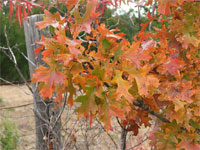
Texas red oak (Quercus buckleyi)
Just up ahead there’s a nice stand of colorful red oaks, most likely the Texas red oak (Quercus buckleyi). Yeah, they look similar to Shumard oaks (Q. shumardii), but because of the location, growing site, and the size and multi-trunked habit of mature specimens nearby, I’m thinking Texas red. You know, there’s a thin line of hybridization between these two species that runs basically from Gainesville to San Antonio (Texas red to the west and Shumard to the east), which makes positive ID a little dicey in this part of the country. You’re looking at me like that again. OK, let’s just say they’re simply pretty trees that have evolved to life atop these thin-soiled escarpments and are almost bulletproof except for oak wilt, which is a fungus that plugs up the vascular system of red and live oaks and can be fatal to them, often in just a matter of weeks. Oak wilt is spread three ways: through natural root grafts, by tiny Nitidulid beetles, and by people. Sometimes folks spread the fungus with their pruning tools, other times by moving fungus-infected firewood. And sometimes people prune their oaks during “oak wilt season” (February to June), causing wounds that attract the Nitidulid beetles. Personally, if I have to prune an oak at any time of year, I follow the cut immediately with brown latex spray paint. (Don’t use that asphalt pruning paint … it’s not good for your trees.)
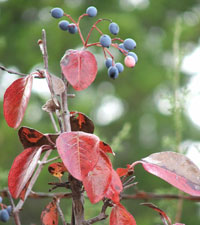
Rusty blackhaw (Viburnum rufidulum) with blue fruits
OK, we’re heading onward (“through the fog” don’tcha know). But first, check out that little rusty blackhaw (Viburnum rifidulum) growing in with that last red oak. Yeah, that thing with the cool blue berries on it. Well, technically, they’re drupes. Botanically, they’re the same type of fruit as cherries, and yes, they are edible. Not as sweet as cherries, more like raisins. Rusty blackhaw is an amazing four-season plant — nice fall foliage color, interesting branches and fruit in the winter, lovely white flower clusters in spring, and shiny, bright green leaves all summer. OK, OK … I’m driving. Ya know, there’s such a thing as “taking time to smell the roses.”
Hey, while we’re over in this neck of the woods, let’s hit Clark Gardens. Nice guy, that Mr. Clark. Tough as nails, too. I came out here one blazing hot August day and he was out in the garden working … in the sun. I was about to die, but it didn’t seem to bother him a bit. He talked of building a hiking trail out to the entrance one day, and I’ll be dogged … there it is.
Tell you what, since I’m buying the gas, you drop the admission fee in the honor box over there. And don’t be stingy … it costs a fortune to keep this place green year ‘round. Don’t make me launch into my famous “why a garden is a better value than a movie” speech. Thanks … bet you feel good now, too.
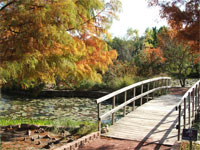
Bridge and bald cypress (Taxodium distichum) at Clark Gardens
Check out the bald cypress trees! Bald cypress (Taxodium distichum) grows all up the eastern side of the U.S., but isn’t really native this far west. Given a decent water supply, it grows in a perfect pyramid shape to about 80 feet, though older trees tend to form wider, more rounded crowns. Some people think these trees must grow at water’s edge, but that’s simply not true … they’ll do fine with normal garden irrigation. And from what I’ve seen, they tend not to form those root “knees” unless they’re growing in saturated soils. I just love that rusty red color they turn in the fall before they drop their leaves.
True story — there was a lady visiting out here who told me it was horrible to see all the damage the garden had suffered. Since all I had seen was a little frost-singed sweet potato, I inquired about the location of the damage. She pointed to the long row of bald cypresses growing along the lakeshore, and said, “It’s just horrible.” I stifled a chuckle and told her they were deciduous trees, and that coloring was just the natural fall foliage. She paused, reflected for a moment, and added, “Well, I guess then they’re kind of pretty.”
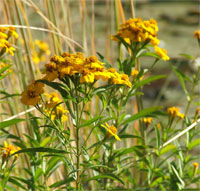
Mexican mint marigold (Tagetes lucida) at Clark Gardens
Not far away, a drift of Mexican mint marigold (Tagetes lucida) in full flower catches my eye. Bright yellow blossoms adorn 30-inch stems in autumn, right about the time the Monarchs are migrating through, though I am uncertain if they utilize it as a nectar source. (Monarchs feed on the nectar of many species of plants, but lay eggs only on milkweeds.) The leaves are kind of rubbery feeling, and release the scent of licorice or anise when crushed or used in cooking. (Hint: add at the end, as heat diminishes the flavor.) Some folks are now calling this “Texas tarragon” because it is a great substitute for and easier to culture than the often fussy French tarragon. Insect-, disease-, and deer-resistant, it is perfectly at home in perennial, butterfly, herb, and children’s gardens.
Five hours pass….
OK, I guess we can leave now. Weren’t the ducks and the swan cool? One more stop real quick before we head in for the day. Right across 180, there’s a Vietnam War memorial and garden. Pretty small at the moment, but there’s a museum planned for the site one day.
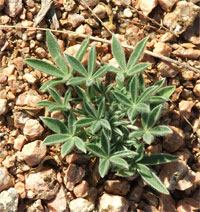
Bluebonnet seedling (Lupinus texensis)
Yes, that is a labyrinth. Nice to see you’re still paying attention. Weeds? What do you mean weeds growing all over the pathways? You’d better look closer … those are baby bluebonnets. Yeah, I know they don’t look like much now, but those little inch-tall seedlings will stay small over the winter. Underground, they’re expanding their root systems. About mid-March, they’ll kick it into high gear and put on a spectacular show until early May. Makes me feel grateful to see a little promise of spring right here in the fourth week of November. Some might even interpret that as just one more reason to be thankful for the beauty and wonder nature has bestowed on the Lone Star State. And I’m thankful for the service men and women who worked so hard and fought and died so that you and I can have the freedom to enjoy it all.
Thanks for joining me on my road trip today. Hope you had as a good time as I did. Nothing like a little road trip to clear out the cranial cobwebs and remind us of the beauty that surrounds us every day. Peace & love, baby, peace & love.
About the author: Steven Chamblee is the chief horticulturist for Chandor Gardens in Weatherford and a regular contributor to Neil Sperry’s GARDENS magazine and e-gardens newsletter. Steven adds these notes:
We’re getting in the holiday spirit! Come out to Chandor Gardens between Dec. 1 and Jan. 6 to see the garden dressed in lights and old-fashioned garlands. Just take I-20 west to exit 409, hang a right, go 2.1 miles and hang a left on Lee Avenue. Head straight 12 blocks and you’re driving in the gates. Call 817-361-1700 for more information. You can always go to www.chandorgardens.com for a picture tour and more information.
I can always use another road trip! Let me know if you’d like me to come out and speak to your group sometime. I’m low-maintenance, flexible, and you know I like to go just about anywhere. No city too big; no town to small. Just send me an e-mail at schamblee@weatherfordtx.gov and we’ll work something out.

